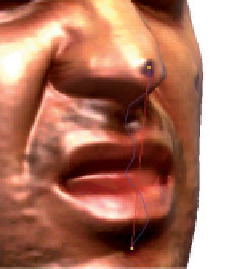Graphics Reference
In-Depth Information
contrast the geometry of a surface with that of a curve. The points along a curve have a fixed
ordering that allows us to impose a coordinate system for studying shapes of curves. Although
the parametrization for a curve may not be unique, the task of analyzing the shapes of curves
modulo all possible parametrizations are still tractable. More specifically, the space of all
possible parametrizations of a curve is the set of all one-dimensional diffeomorphisms, and
there exist efficient algorithms (such as the dynamic programming algorithm) for optimally
matching curves over all parametrizations. For surfaces, there is no natural ordering of points
and, hence, no natural way of parametrizing them. Thus, the goal of analyzing shapes of
surfaces, modulo all possible reparametrizations, becomes quite difficult to achieve and leads
to enormous computational challenges.
3.2 Facial Surface Modeling
Let
S
1
and
S
2
be two facial surfaces modeled as Riemannian manifolds. The two faces belong
to the same person, but
S
1
is a neutral face, whereas
S
2
is an expressive one. Let
f
:
S
1
→
S
2
be a diffeomorphism modeling the expression (see Figure 3.1).
Definition 3.2.1
Diffeomorphism
A smooth map f
:
S
1
→
S
2
that are bijective and whose
inverse f
−
1
S
1
is smooth is called
diffeomorphism
. If there is a diffeomorphism
between them, S
1
and S
2
are said to be diffeormorphic.
:
S
2
→
Definition 3.2.2
Isometry
S
2
is called
an isometry if it takes curves in S
1
to curves of the same length in S
2
. If an isometry f
:
S
1
→
If S
1
and S
2
are surfaces, a diffeomorphism f
:
S
1
→
S
2
exists, we say that S
1
and S
2
are isometric.
In Bronstein et al. (2005), the authors assume that facial expressions can be modeled as
isometries of the facial surface. This assumption reduces the problem of comparing faces in the
presence of facial expressions to the problem of isometric surface matching. Indeed, Bronstein
et al. (2005) placed 133 markers on a face and computed the distances between these points
under facial expressions deformations. The distribution of the absolute change of the geodesic
f
Neutral face
Expressive face
Figure 3.1
Points correspondence (neutral face at left and expressive face at the right)






